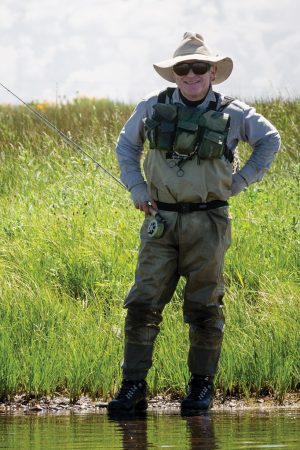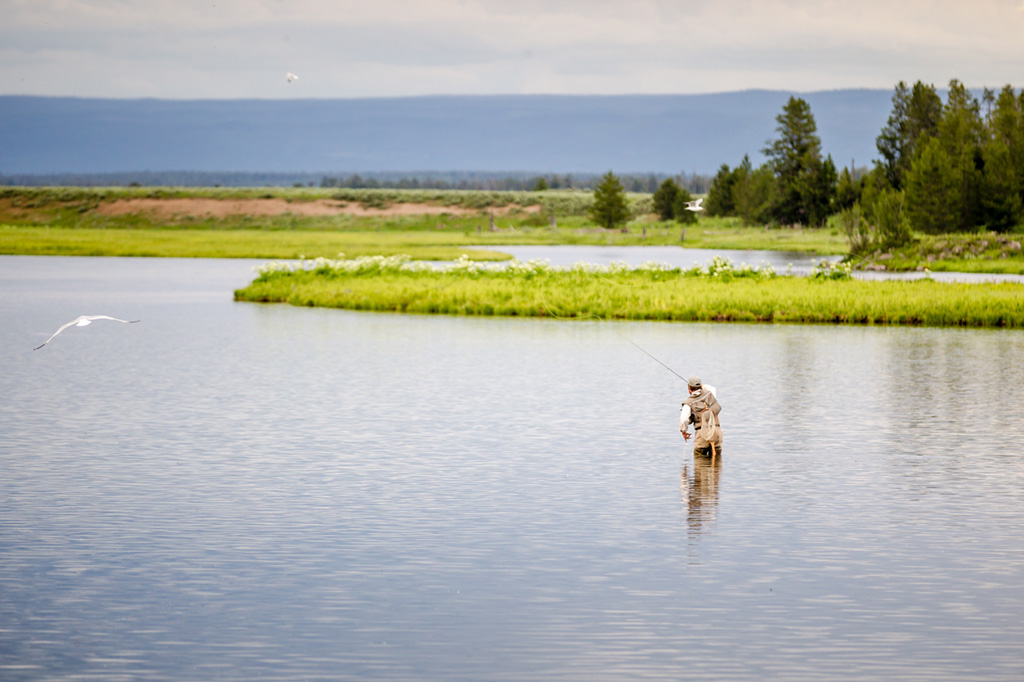The Railroad Ranch on the Henry’s Fork of the Snake River is endowed with one of the most tranquil, yet wild confluences of natural beauty in the western region. “The Ranch,” discovered in the late 19th century and pioneered in the early 20th century by the Guggenheim, Harriman, and Jones families, is deep in history and beauty alike. The region is truly an outdoorsman’s playground and trout bum’s paradise.
In the eastern corner of Idaho, the thinly populated, yet cultured town of Island Park rests at 6,290 feet, making it the highest city in the state of Idaho. In the base of the Henry’s Fork Caldera, the area’s high elevation, relatively flat ground and abnormally high precipitation levels provide the geographical context for what becomes a beautiful natural expression. The river itself flows from the Island Park Reservoir, through the “Box Canyon,” and is eventually ushered in to the sacred 8½-mile stretch known as The Railroad Ranch.

John McDaniel takes a break at the “islands’ of the Ranch section. Photo: Bryan Gregson Photography.
Conserved within The Harriman State Park, The Ranch fuses a traditional tailwater fishery signified by the cold-water release from the bottom of the reservoir with a serene spring creek fishery like the Silver Creek Preserve. With a consistent width of approximately 300 feet, a minimal gradient change, and clean, practically rock-free substrate, the river’s slow, flat, uncontained nature creates the open spaces needed for massive rainbow trout to exercise their acrobatic nature. Finally, the cold, nutrient-rich water provides an incubator for prolific aquatic insect production, thus completing the structure of a truly unparalleled “fish factory.”
There is one man who has religiously devoted 36 seasons fishing arguably the world’s most selective rainbow trout. John McDaniel, an Emeritus Professor in Anthropology at Washington and Lee, has meticulously documented each of the 13,233 hours he has invested on the 8½ miles. The guide has landed 2,001 trout of 17 inches or longer (he doesn’t count fish under 17 inches). A little over 94 percent of the fish (1,987) were caught with dry flies while the other roughly 6 percent were taken sight nymphing, a technique in which the angler precisely casts a nymph (wet fly imitation), with no indicator, to spots in the river where he or she can see the trout below the water’s surface.
In McDaniel’s opinion, “What speaks to the remarkable fishery is that no less than 706, or 33.6 percent of the fish were at least 20 inches in length. The aspects that routinely capture anglers are: the sheer difficulty of the dry fly fishing, the beauty of the river, and the psychological calmness conferred by the water.”
Due to the tranquil nature of the water and the abundant insect production, the trout express highly selective feeding behavior. Thus, most fly-fishermen will wait and “hunt” for actively feeding trout from the banks of the river. It is common to see fishermen sitting, kneeling or stealthily walking the banks, patiently resisting the urge to cast in order to find the active fish. This style of fishing cultivates a more social experience in which anglers will often exchange information, hatch observations, and fish tales.
Thus, despite the wonderful angling opportunities in the greater Wood River Valley, my call to action in 2019 is to take the short four-hour drive to a “backyard” river that has routinely drawn anglers from all corners of the world. Whether a fly fisherman, naturalist, outdoorsman, or one who recognizes the soul shaking effect of the natural world, get out, visit, and, as Silas Eccles described to E.H. Harriman in 1908, “Camp out in places that are romantic, wild, and delightful …”


